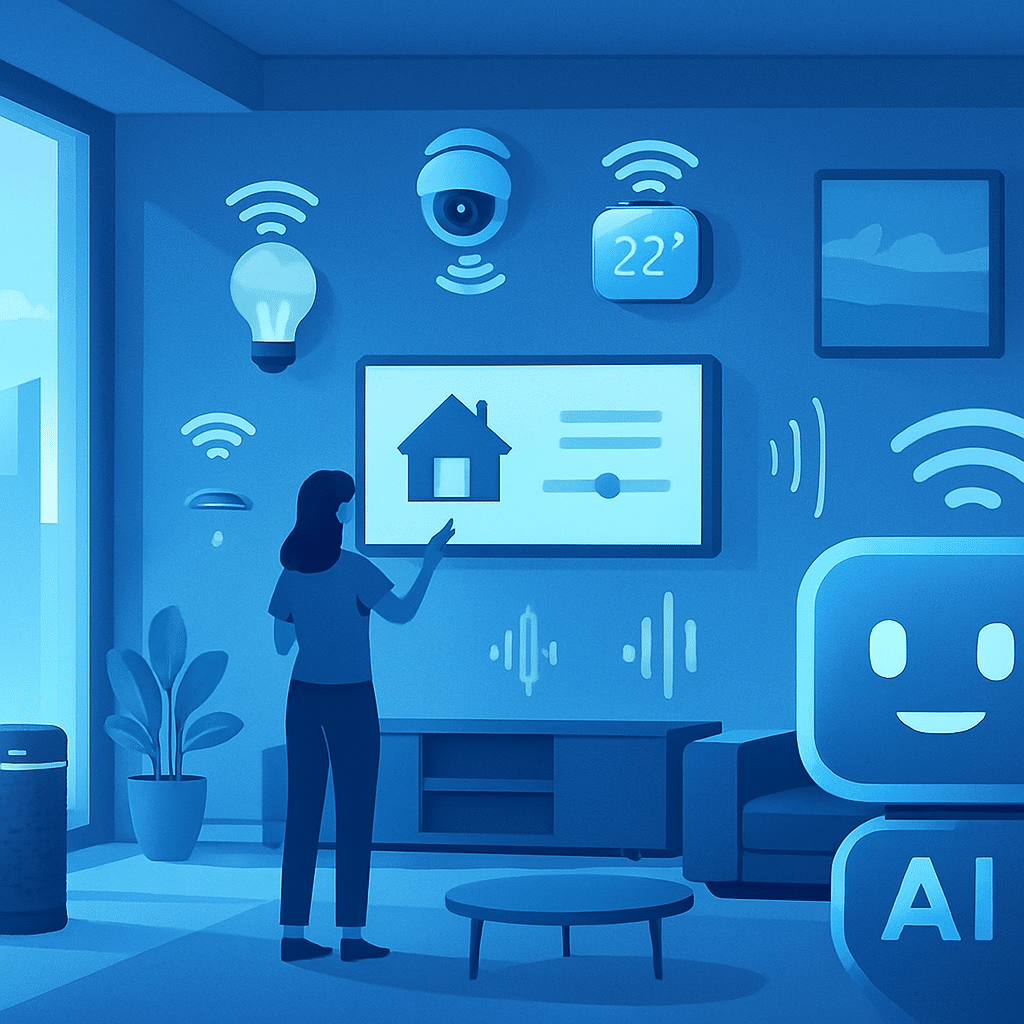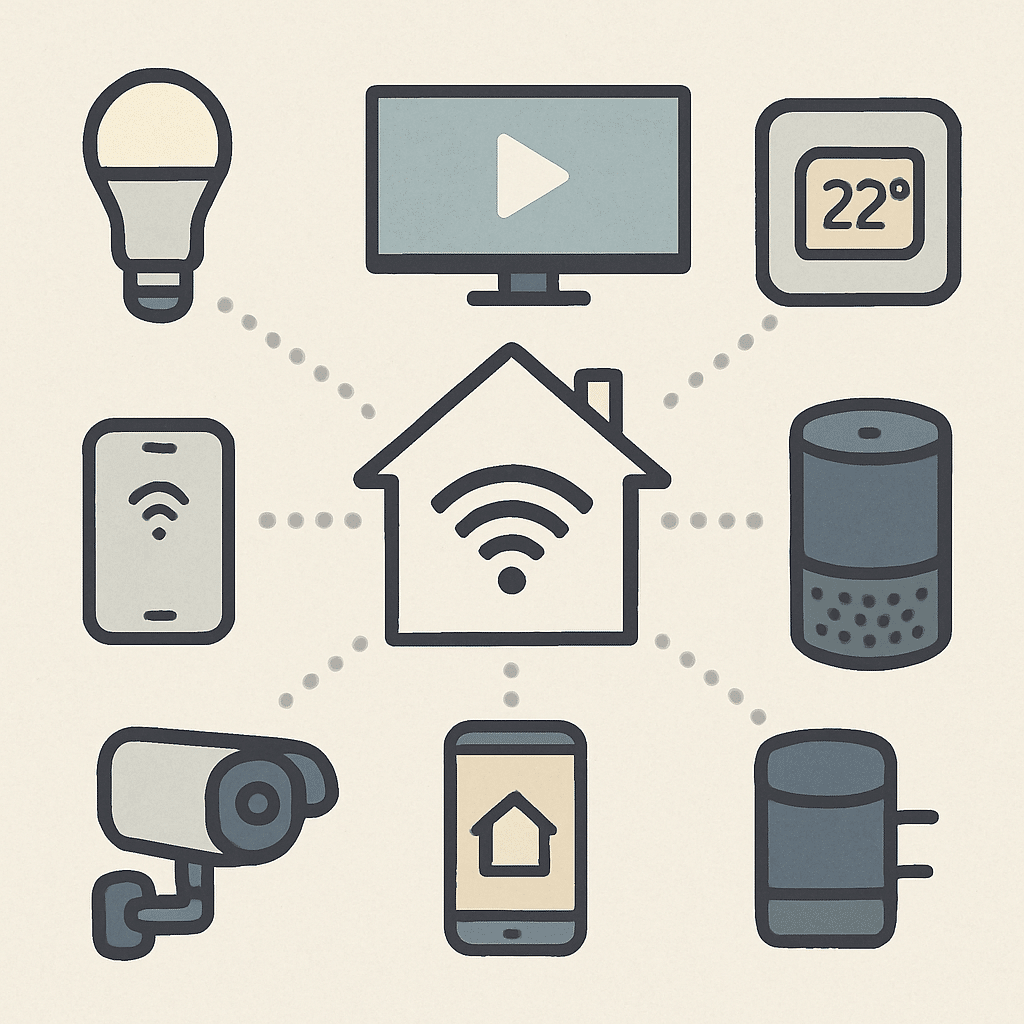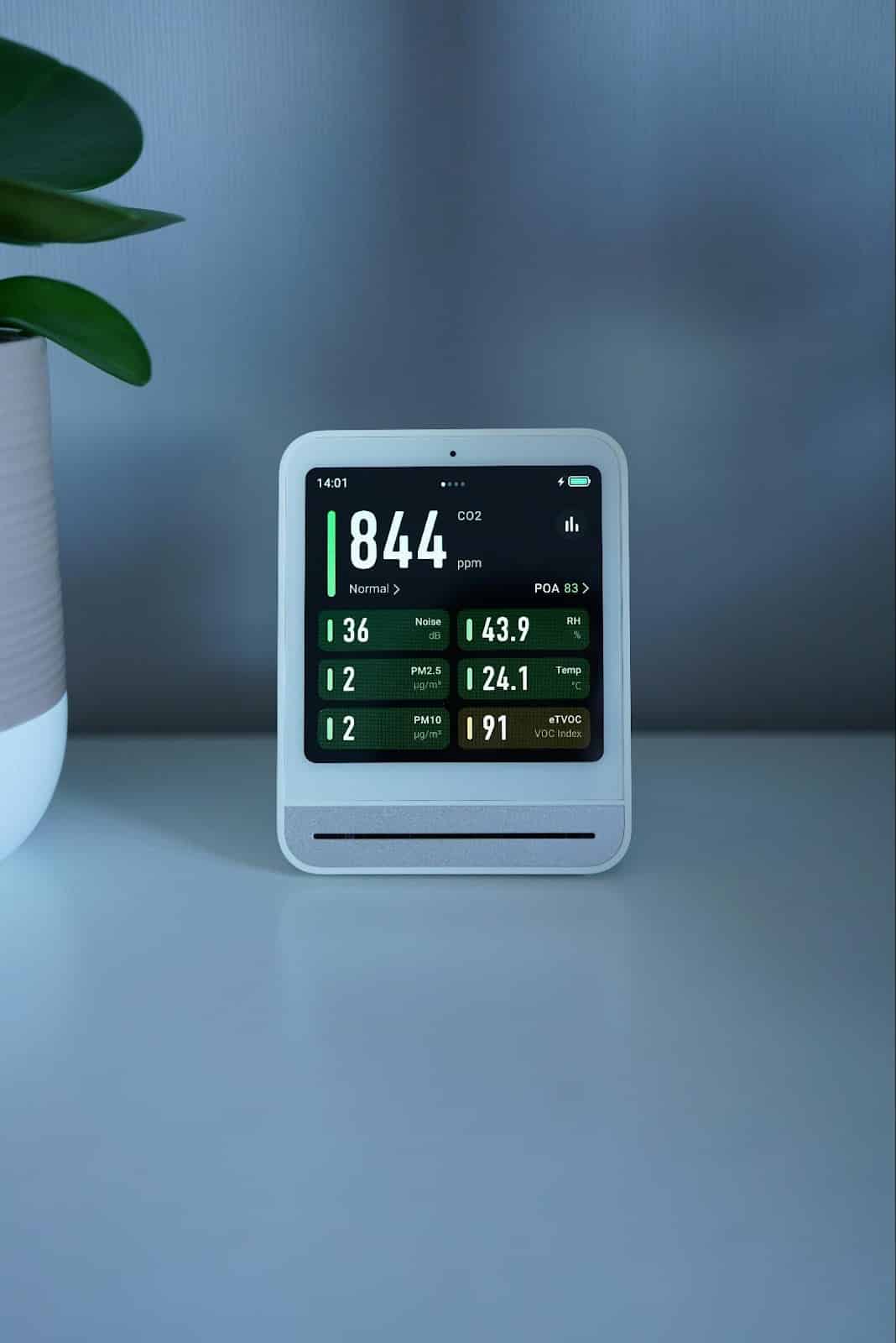AI-Powered Ambiance Smart Homes That Predict Your Every Mood
Imagine a home that knows your mood before you do.
AI-powered smart homes are transforming this vision into reality.
These homes use advanced technology to create a personalized living experience.
They adapt to your habits and preferences seamlessly.
Smart thermostats with AI optimize energy use, saving money and resources.
Voice-controlled home lighting offers convenience and accessibility at your command.
Mood-sensing home technology adjusts settings to match your emotional state.
This creates a harmonious and intelligent home environment.
AI home automation integrates devices for a cohesive ecosystem.
The result is a smart home ambiance control system that enhances comfort and efficiency.
AI home security systems provide peace of mind with advanced protection.
These innovations are part of the latest smart home trends.
They focus on personalization and user-centric design.
The future of smart homes lies in continuous AI development.
This promises to improve quality of life and sustainability.
Welcome to the era of AI-powered smart homes.
The Rise of AI-Powered Smart Homes: A New Era of Living
AI-powered smart homes represent a significant evolution in residential technology. They combine artificial intelligence with smart home devices to provide a new level of convenience and efficiency. This technological leap is reshaping how we interact with our living spaces.
Smart homes with AI bring automation and personalization together. They learn from user behaviors, adapting to create an environment that suits individual needs. The integration of various devices through AI allows for a seamless and harmonious home ecosystem.
Key features of AI-powered smart homes include:
- Smart thermostat with AI optimizing energy use
- Personalized smart home experiences
- AI mood prediction systems
These features work in concert to improve daily living. They also enhance home security and energy efficiency, making them attractive to modern homeowners.
The rise of AI in smart homes is part of a broader trend towards more intuitive residential technology. It focuses on user preferences and provides a living experience that anticipates and reacts to individual moods and needs.
As technology continues to advance, the concept of AI-powered living will become even more prevalent.
How AI Understands and Predicts Your Mood
AI mood prediction systems are transforming how smart homes interact with residents. They gather data from various sources to interpret user emotions. This process creates a more personalized and responsive living space.
Such systems rely on data from wearables, voice analysis, and environmental sensors. These inputs help AI algorithms determine mood changes throughout the day. The goal is to adapt the home environment accordingly, enhancing comfort and well-being.
Key elements used in mood prediction include:
- Wearable devices tracking physiological signals
- Microphones analyzing voice tone
- Sensors monitoring environmental factors
Each element plays a crucial role in understanding mood shifts. By analyzing this data, the smart home can adjust various features. This might involve changing lighting or altering the temperature to suit your current mood.
AI’s ability to predict emotions isn’t just about comfort. It also contributes to mental wellness by optimizing the home ambiance. An environment that aligns with your emotions can reduce stress and enhance relaxation.
As this technology advances, the capability of smart homes to understand nuances in human behavior will improve. Future developments will likely offer even more refined and accurate predictions.
Personalized Smart Home Experience: Beyond Automation
A personalized smart home experience transcends basic automation. It offers an environment tailored specifically to individual preferences. AI technologies are central to creating this unique living experience.
Smart homes now learn your daily routines and adapt accordingly. They anticipate needs, offering proactive solutions. This adaptability goes beyond scheduled tasks, involving real-time decision-making.
The integration of AI systems allows:
- Learning user habits
- Customizing environmental settings
- Enhancing user convenience and comfort
By understanding behavior patterns, smart homes can anticipate your needs before you express them. For instance, your house might automatically play calming music when sensors detect stress.
Additionally, AI-powered homes remember specific settings for different family members. This means everyone experiences comfort according to their unique preferences.
A truly personalized smart home does more than respond; it engages with residents. It learns over time, ensuring each interaction becomes more suited to personal needs.
Such homes evolve continuously, guaranteeing that users enjoy a customized, hassle-free living environment. This integration brings a new dimension to the concept of a smart home.
Mood-Sensing Home Technology: The Science Behind the Magic
Mood-sensing home technology might sound futuristic, but it’s very real. At its core, it combines sensory data and AI algorithms. This synergy allows homes to adjust settings based on emotional cues.
The technology uses data from various sensors. These include environmental and biometric sensors like temperature, light, and even heart rate. The AI then analyzes this information to decipher your mood.
Key components of mood-sensing technology include:
- Biometric sensors: Monitor physiological responses
- Environmental sensors: Track changes in the home environment
- AI algorithms: Analyze data to predict emotional states
These components work together to create dynamic home environments. For example, if you’re stressed, the system might dim lights and play soothing music. This immediate responsiveness offers an unparalleled personalized experience.
Mood-sensing technology transforms how we interact with our homes. It’s not just about convenience; it enhances emotional well-being. As AI continues to evolve, expect even more nuanced mood detection capabilities in smart homes.
Adaptive Lighting and Ambiance Control: Setting the Perfect Scene
Adaptive lighting reshapes home interiors effortlessly. This smart home feature adjusts lighting based on time, weather, and mood. Its aim? To create the ideal atmosphere for any occasion.
The technology employs sensors that detect ambient light levels. AI algorithms then fine-tune the brightness and color. By tailoring these aspects, it fosters a comfortable living space.
Key benefits of adaptive lighting include:
- Energy efficiency: Lights adjust automatically
- Mood enhancement: Colors and brightness match your emotions
- Customization: Settings adapt to routines and preferences
With this technology, your home evolves with your needs. Whether reading, cooking, or relaxing, the lighting adapts seamlessly. It allows for an inviting and productive environment.
Adaptive lighting contributes to energy conservation too. It maximizes natural light usage, reducing electricity consumption. This eco-friendly approach aligns with modern sustainable living trends.
Such innovations make everyday living more enjoyable. Smart ambiance control offers practicality and personalization. It transforms homes into sanctuaries of comfort.
Smart Thermostat with AI: Comfort Meets Efficiency
A smart thermostat with AI offers the perfect blend of comfort and efficiency. These intelligent devices learn from your habits, optimizing indoor temperatures seamlessly.
By analyzing patterns, the thermostat predicts when to heat or cool. It adjusts settings automatically, ensuring your home remains comfortable. This smart home technology adapts to changes, offering personalized comfort.
Benefits of using a smart thermostat with AI include:
- Energy savings: Adjusts temperature based on occupancy
- Cost efficiency: Reduces energy bills significantly
- Personalized comfort: Learns preferred settings for optimal climate
These thermostats contribute to both convenience and sustainability. They harness weather forecasts to further enhance performance, ensuring efficiency and reduced energy use.
Moreover, users can control them remotely via mobile apps, adding flexibility to their day-to-day activities. This convenience allows for adjustments even when you are not home.
In conclusion, the integration of AI in thermostats ensures smarter energy consumption. It represents a significant step towards a more efficient and sustainable home environment.
Voice-Controlled Home Lighting and Devices: Seamless Interaction
Voice-controlled home lighting offers effortless convenience. It allows you to adjust settings without lifting a finger. This technology brings ease to everyday tasks.
These systems understand simple voice commands. You can dim lights, change colors, or switch off all lights with a phrase. This feature enhances accessibility for users of all ages.
Benefits of voice-controlled home devices include:
- Hands-free operation
- Increased accessibility
- Enhanced convenience for multi-tasking
Integration with virtual assistants like Alexa or Google Assistant allows broader device control. You can manage other smart devices, like security cameras or thermostats, by voice.
This technology promotes seamless interaction with your home. It’s particularly beneficial in high-traffic areas or when your hands are full. As smart home trends evolve, voice control will likely become even more intuitive and responsive.
AI Home Security: Intelligent Protection for Peace of Mind
AI home security systems offer enhanced safety. These systems use advanced technologies such as facial recognition. They can differentiate between family members and strangers.
This technology allows for smarter, more responsive protection. AI detects unusual behaviors and alerts you instantly. You gain peace of mind knowing your home is secure.
Key features of AI home security include:
- Facial recognition capabilities
- Behavior analysis for threat detection
- Real-time alerts and notifications
These systems can integrate with other smart home devices. This integration creates a cohesive security network, improving both safety and reliability. As AI technology evolves, home security systems will become more intuitive.
The promise of AI in home security is significant. It ensures that your home is not only safe but also intelligently monitored. Embrace AI-driven security for a worry-free living environment.
by Samsung Memory (https://unsplash.com/@samsungmemory)
Integrating AI Home Automation: Building an Intelligent Home Environment
Integrating AI home automation brings unparalleled convenience. It creates a seamless interaction between devices. AI ensures these devices communicate effectively, enhancing user experience.
This technology forms the backbone of an intelligent home environment. It streamlines operations, saving time and effort. With AI, your home efficiently adapts to your lifestyle.
Key benefits of integrating AI home automation include:
- Optimized energy usage
- Seamless device interaction
- Enhanced personalized experiences
AI integration elevates how homes operate. Automation handles routine tasks without manual input. This change allows homeowners to focus on more meaningful activities.
As AI in home automation advances, homes become smarter. These innovations promise more efficient and user-centric living spaces. The future of home automation lies in its continuous evolution.
Smart Home Trends: What’s Next for AI-Powered Living?
Smart home trends continue to revolutionize living environments. These advancements aim to make home automation increasingly intuitive. AI is at the forefront, driving these transformative changes.
One trend is the integration of artificial intelligence with Internet of Things (IoT) devices. This merger enhances connectivity, creating a more cohesive experience. Homes become more responsive and proactive as a result.
Notable smart home trends to watch include:
- Enhanced AI learning capabilities
- Integration with wearable tech
- Expansion of voice-controlled functionalities
Personalization is becoming a key trend in smart home technology. Homes learn and adapt to unique user habits. This shift is making smart homes more accessible and user-friendly.
As we look to the future, the focus shifts towards creating truly predictive living environments. This involves reducing energy consumption and enhancing quality of life. AI-powered homes promise a new era of sustainable and intelligent living.
by Tom Krach (https://unsplash.com/@tomkrach)
Challenges and Considerations: Privacy, Security, and Accessibility
AI-powered smart homes bring privacy concerns. Collecting data from daily activities raises questions. Managing this data responsibly is crucial.
Security in smart homes is another challenge. As homes become more connected, they may become vulnerable. Protecting these systems from breaches is vital.
Considerations for AI-powered smart homes include:
- Data privacy management
- System security enhancements
- Accessibility for all users
Accessibility should not be overlooked. Smart home technology needs to be inclusive. It must cater to users with various abilities.
Addressing these challenges is essential for the sustainable growth of AI-powered living. Responsible development will ensure a secure and inclusive future for everyone.
The Future of AI-Powered Smart Homes: Toward Truly Predictive Living
The future of AI-powered smart homes is exciting and transformative. Advancements in AI technology promise even greater personalization. Homes will soon anticipate needs before users voice them.
Predictive living will redefine comfort and efficiency. Smart systems will analyze patterns and optimize resources. These homes will enhance every aspect of daily life, making it more seamless.
AI innovation in smart homes is continuous and dynamic. As technology evolves, intelligent homes will become more intuitive. The ultimate goal is to create spaces that adapt effortlessly, elevating living experiences beyond imagination.
Conclusion: Embracing the Intelligent Home Revolution
AI-powered smart homes represent a breakthrough in modern living. They offer unprecedented comfort and efficiency. These innovations enhance our daily routines and elevate our lifestyles.
As AI continues to evolve, its role in smart homes will expand. Embracing this intelligent revolution is essential for a future where homes seamlessly predict and fulfill our needs.







